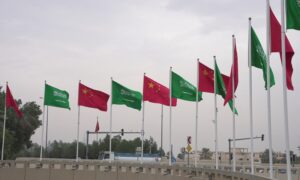China Completes New Highway Near De Facto Border With India
The highway will enable the People’s Liberation Army to mobilize troops and military equipment faster overland to the Line of Actual Control.
China has completed construction of a strategic highway linking Pad Township in Nyingchi city with Baibung in Medog County. The 67.22-kilometer-long highway was constructed at a cost of $310 million and took almost seven years to complete, according to Xinhuanet. It cuts the distance between Nyingchi and Baibung from the current 346 kilometers to 180 kilometers, and reduces travel time by eight hours.
The new highway is of concern to India as it will improve China’s overland connectivity infrastructure near the disputed India-China border. It will enable China’s People’s Liberation Army (PLA) to mobilize troops and military equipment faster overland to the Line of Actual Control (LAC), the de facto but undefined border between the two countries.
Medog County is located in the southeast of the Tibet Autonomous Region (TAR). To its south lies the Indian state of Arunachal Pradesh, where China claims around 90,000 square kilometers of territory as part of what it calls “South Tibet.” During the 1962 Sino-Indian war, China occupied territory in Arunachal Pradesh (then part of India’s North-East Frontier Agency) but subsequently withdrew.
China has rapidly built up its infrastructure near the LAC and the new highway is the latest in a string of roads and railway lines it has constructed in its vicinity in recent years.
Medog used to be a hard to access. It didn’t have roads and people had to undertake arduous treks to reach this area. This changed in 2013, when China completed construction of the first highway into Medog. With this, Medog got hooked on to China’s vast highway network.
Enjoying this article? Click here to subscribe for full access. Just $5 a month.
The new highway is China’s second into this remote and strategically significant area. It runs through the Grand Canyon of the Yarlung Zangbo river (known as the Brahmaputra in India), one of the deepest gorges in the world.
In addition to roads, Beijing has been expanding its railway network in TAR too.
Diplomat Brief Weekly Newsletter N Get briefed on the story of the week, and developing stories to watch across the Asia-Pacific. Get the Newsletter
In 2006, the first train chugged into Lhasa from Qinghai. The Golmud-Lhasa line was extended up to Xigaze in 2014. And Beijing is now linking Chengdu in Sichuan with Lhasa by rail. When completed, the railway line will run through Nyingchi.
Nyingchi is an important part of the road network that China has built in recent years as well. The recently constructed highway to Medog County, for instance, runs from Nyingchi City.
While the Chinese media has often drawn attention to the economic dividends of the road and railway network running up to the border areas, it will be hard for India to disregard the strategic implications.
Around 16 kilometers from the LAC, Nyingchi lies to the north of India’s Tuting sector in the Upper Siang district of Arunachal Pradesh. The PLA’s 52nd and 53rd Mountain Infantry Brigades are headquartered in this town. Nyingchi’s airport is a dual-use airport too. Improved overland connectivity infrastructure to Nyingchi and Medog County will enable the PLA to mobilize swiftly to the LAC in the event of hostilities erupting between China and India.
India has also stepped up construction of roads near the LAC. In the pipeline are three major roads, the Arunachal Frontier Highway, the Trans-Arunachal Highway and the Arunachal East-West Corridor. However, work on these highway projects is still at an early stage.
Given the slow pace at which India’s border roads projects have moved, it will be a long time before these roads to the eastern sector of the LAC become operational.













